Sharing electrons - Study guides, Class notes & Summaries
Looking for the best study guides, study notes and summaries about Sharing electrons? On this page you'll find 1898 study documents about Sharing electrons.
Page 4 out of 1.898 results
Sort by

-
IB Chemistry SL: Topic 4 Latest Version Graded A
- Exam (elaborations) • 30 pages • 2024
-
Available in package deal
-
- $10.49
- + learn more
IB Chemistry SL: Topic 4 Latest Version Graded A Ionic Bond Electrostatic attraction between oppositely charged ions Covalent Bond Electrostatic attraction between a pair of electrons and positively charged nuclei, formed as a result of electron sharing Metallic Bond Electrostatic attraction between a lattice of positive ions and delocalized electrons Polyatomic ions ions with more than one element e.g. CaCO3, Al(OH)3, Mg(NO3)2, (NH4)2SO4, Ba3PO4, LiHCO3 Lattice ions arran...
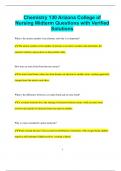
-
Chemistry 130 Arizona College of Nursing Midterm Questions with Verified Solutions
- Exam (elaborations) • 22 pages • 2024
-
- $9.99
- + learn more
Chemistry 130 Arizona College of Nursing Midterm Questions with Verified Solutions What is the atomic number of an element, and why is it important? The atomic number is the number of protons in an atom’s nucleus and determines the element's identity and position on the periodic table. How does an ionic bond form between atoms? An ionic bond forms when one atom donates an electron to another atom, creating oppositely charged ions that attract each other. What is the diffe...
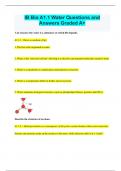
-
IB Bio A1.1 Water Questions and Answers Graded A+
- Exam (elaborations) • 24 pages • 2024
- Available in package deal
-
- $9.99
- + learn more
IB Bio A1.1 Water Questions and Answers Graded A+ List reasons why water is a substance on which life depends. A1.1.1 - Water as medium of life. 1. The first cells originated in water. 2. Water is the "universal solvent" allowing it to dissolve and transport molecules around a body. 3. Water is a metabolite in condensation and hydrolysis reactions. 4. Water is a temperature buffer in bodies and ecosystems. 5. Water maintains biological structures (such as phospholipid bilay...

-
MCAT Study Set verified already passed
- Exam (elaborations) • 304 pages • 2024
- Available in package deal
-
- $21.99
- + learn more
MCAT Study Setcovalent bond formed via the sharing of electrons between two elements of similar EN bond order refers to whether a covalent bond is a single, double, or triple bond. As bond order increases, bond strength increases, bond energy increases, bond length decreases ionic bonds formed via the transfer of one or more electrons from an element with a relatively low IE to an element with a relatively high electron affinity - cation: postiive - anion: negative
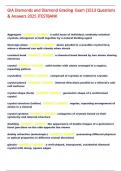
-
GIA Diamonds and Diamond Grading Exam {1513 Questions & Answers 2025 }TESTBANK
- Exam (elaborations) • 118 pages • 2024
-
- $22.49
- + learn more
GIA Diamonds and Diamond Grading Exam {1513 Questions & Answers 2025 }TESTBANK Aggregate - CORRECT ANSWER a solid mass of individual, randomly oriented crystals, intergrown or held together by a natural binding agent Cleavage plane - CORRECT ANSWER plane parallel to a possible crystal face, where a diamond can split cleanly when struck covalent bond - CORRECT ANSWER a chemical bond formed by two atoms sharing electrons crystal - CORRECT ANSWER solid matter with atoms arranged in a r...

-
SFSU Bio 230 exam 2024 with 100% correct answers
- Exam (elaborations) • 20 pages • 2024
-
- $16.49
- + learn more
d. one of the atoms sharing electrons is much more electronegative - correct answer A covalent bond is likely to be polar if _____ a. it is between two atoms that are both very strong electron donors b. the two atoms sharing electrons are equally electronegative c. it is between two atoms that are both very strong electron acceptors d. one of the atoms sharing electrons is much more electronegative e. the two atoms sharing electrons are of the same element e. is weak - correct answer...
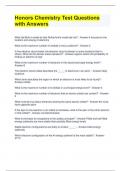
-
Honors Chemistry Test Questions with Answers
- Exam (elaborations) • 32 pages • 2024
-
- $12.99
- + learn more
Honors Chemistry Test Questions with Answers What did Bohr's model do that Rutherford's model did not? - Answer-it focused on the location and energy of electrons What is the maximum number of orbitals in the p sublevel? - Answer-3 In the electron cloud model, the electron cloud is denser in some locations than in others. What do the denser areas represent? - Answer-regions where the probability of finding an electron is high What is the maximum number of electrons in the second pri...

-
Seminole State Campell Biology Final Exam Review Questions And Answers Rated A+ New Update Assured Satisfaction
- Exam (elaborations) • 15 pages • 2024
-
- $9.69
- + learn more
In the case of H20, the oxygen atom covalently bonds unequally with 2 hydrogen atoms. This is why H20 is considered a _______ molecule. - polar Electrons are not evenly distributed; at any instant, they may accumulate by chance in one part of a molecule or another, causing every-changing regions of positive and negative charge that enable all atoms and molecules to stick to one another, known as - Van der Waals interactions. Which statement is true of all atoms that are anions? - The atom h...

-
BIO 210 - FINAL EXAM REVIEW LATEST UPDATE GRADED A+
- Exam (elaborations) • 23 pages • 2024
- Available in package deal
-
- $9.99
- + learn more
BIO 210 - FINAL EXAM REVIEW LATEST UPDATE GRADED A+ Anatomy the study of structure Physiology the study of function Metabolism all the chemical reactions that happen in our body cells Catabolism the breakdown of complex molecules into simpler ones. Catabolic reaction Anabolism The building up of complex molecules from simpler ones Levels of Structural Organization Atom (chemical), Molecule (chemical), Cell tissue, Organ, Organ System, Organism Homeostasis The maintenance...
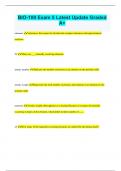
-
BIO-100 Exam 5 Latest Update Graded A+
- Exam (elaborations) • 20 pages • 2024
-
- $9.99
- + learn more
BIO-100 Exam 5 Latest Update Graded A+ elements substances that cannot be divided into simpler substances through chemical reactions 92 There are ___ naturally occurring elements atomic number Indicates the number of protons in an element on the periodic table atomic weight Represents the total number of protons and neutrons in an element on the periodic table neutrons Atomic weight often appears as a decimal because it averages all naturally occurring isotopes of the elemen...

How much did you already spend on Stuvia? Imagine there are plenty more of you out there paying for study notes, but this time YOU are the seller. Ka-ching! Discover all about earning on Stuvia


